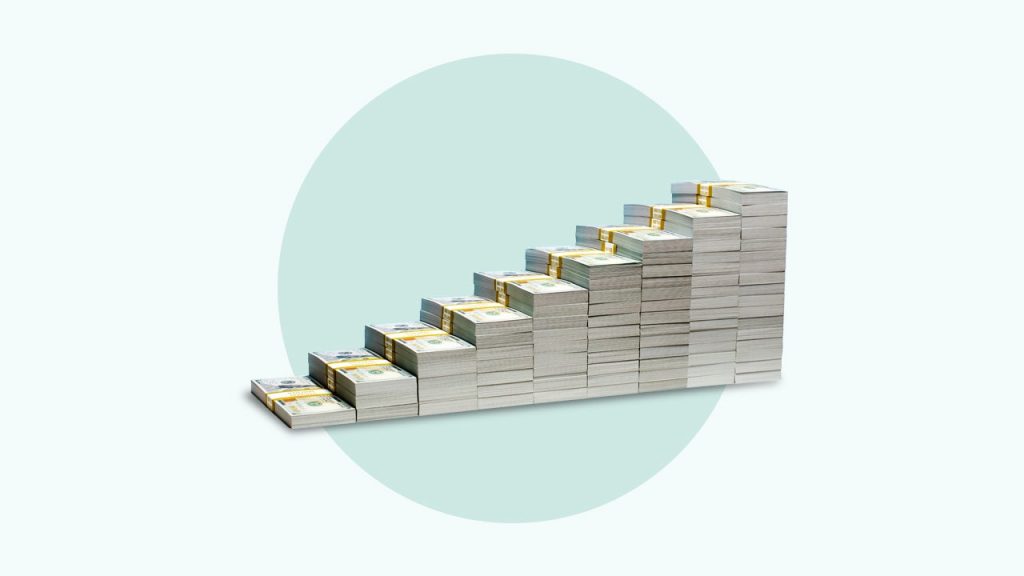PM Images/ Getty Images; Illustration by Austin Courregé/Bankrate
Key takeaways
- Personal loan amounts of $50,000 are offered by banks, credit unions, online lenders and marketplace lending sites.
- Because they’re unsecured, they can be funded quickly.
- Maximum repayment terms are typically seven years, which could mean a high monthly payment.
- An excellent credit score will typically qualify you for the lowest rate on a loan of this size.
If you want to borrow up to $50,000 without collateral — such as a car or home — you may want to check out personal loans offered by your local bank or credit union if you have excellent credit. Online lenders and marketplace lending sites like Bankrate also provide access to funds, though the rates and terms may be more expensive since they tend to cater to lower credit-score borrowers.
Rates range from the mid-six percent range up to 36 percent, making it critical to shop several lenders to make sure you’re getting the best terms possible for the lowest personal loan rate.
Lenders that offer $50,000 personal loans
If you have a good credit score, you can check with your bank or credit union to get a personal loan if they offer them. Online lenders are also an option, and many feature a simple application process and fast funding times. If you’re not sure what you qualify for, an online marketplace can match you to several lenders based on basic information you provide about your income and credit.
| Lender | APR range | Loan amount range | Minimum credit score requirement |
|---|---|---|---|
| LightStream | 6.49%-25.29%* (with AutoPay) | $5,000–$100,000 | 695 |
| SoFi | 8.99%-29.49% (with autopay) | $5,000–$100,000 | No requirement |
| Upgrade | 7.99%-35.99% (with autopay) | $1,000–$50,000 | 580 |
| Best Egg | 6.99%-35.99% | $2,000–$50,000 | 600 |
| Upstart | 6.70%-35.99% | $1,000–$50,000 | No Requirement |

Best personal loans of 2025
Explore Bankrate’s top picks for the best personal loans to find the right lender for you.
Learn more
Bankrate’s view
If you have good or excellent credit, LightStream is worth considering. It offers some of the lowest interest rates on personal loans in the industry, and borrowers can select a loan term and funding date that works best for them. Even better, there are no origination fees, and you won’t be charged a prepayment penalty if you decide to pay the loan off early. LightStream will also beat any competitor’s rate for a comparable personal loan product by 0.1 percent through its Rate Beat program.
Pros
- Low rates compared to competitors
- Rate Beat program
- Funding same business day
Cons
- High minimum credit score requirement
- Prequalification not offered
- Several years of credit history required
Bankrate’s view
SoFi offers prequalification in just 60 seconds with no impact on your credit score. You may receive your loan on the same business day if you’re approved before 7 p.m. ET. Along with its simplified application process, SoFi also extends other perks to its customers, including free access to career education resources, rewards and financial planning. You can get a small interest rate discount for opting into autopay.
Pros
- No origination fees
- Quick prequalification
- Multiple rate discounts available
Cons
- Relatively high starting APR
- Requires good to excellent credit
- Cosigners not accepted
Bankrate’s view
A $50,000 personal loan from Upgrade could be ideal if you have fair credit. You can choose a loan term between two and seven years and a monthly payment that works for your budget. However, you’ll pay an origination fee between 1.85 percent and 9.99 percent when you borrow a loan.
Pros
- Accepts joint loan applications
- Option to prequalify
- Rate discounts available
Cons
- Origination fees
- Late fees
- High maximum APR
Best Egg
If you have a credit score over 700 and income of at least $100,000, you can get Best Egg’s most competitive rates. Loans are also available to borrowers with lower credit scores — just expect higher rates. You could get approved and funded on the same day, and there are no prepayment penalties if you choose to pay the loan off ahead of schedule. However, Best Egg charges an origination fee between 0.99 percent and 9.99 percent.
Pros
- Rate check in minutes
- Approvals based on more than just credit score
- Low rates for good credit
Cons
- No rate discounts available
- Origination fees
- Returned payment fees
-
You can borrow up to $50,000 at Upstart, and you may even qualify if you don’t have a credit score because you’re new to the country or the credit world. It may also be a good match if you have bad credit, although the payment for a large loan amount, combined with Upstart’s maximum 60-month term might be too high for most budgets.
Pros
- Rate check in minutes
- Prequalification options
- Fast funding
Cons
- Shorter repayment terms
- Origination fees
- Qualifying standards not clear
How to get a $50,000 loan
Most lenders base their loan decision for a $50,000 loan on your credit score, income and debt-to-income ratio (DTI). You’ll generally need a higher score for a large loan amount, although lenders don’t disclose what that score is. You’ll also need to prove you have a stable income — even though you may have other debt — to support the higher payment you’ll have with a maximum repayment term of seven years.
Follow these steps to give yourself the best chance at getting approved for a $50,000 loan:
- Check your credit: A fair or bad credit rating doesn’t necessarily mean you can’t get a $50,000 personal loan, but you can expect to pay far more in interest over the loan term. Some featured lenders allow you to add a co-borrower or cosigner to help improve your approval odds.
- Understand DTI: Lenders will scrutinize the percentage of your gross monthly income used to cover minimum monthly debt payments to make sure you can handle the new payment on a $50,000 loan. If it’s too high, lenders may deny the loan or counteroffer a lower loan amount.
- Get prequalified: Explore several lenders and get prequalified with at least three. You can also fill out the form on a marketplace site like Bankrate and lenders will send you prequalified offers.
- Gather documentation: In most instances, you’ll need to provide the lender with identifying documents, including proof of identity, address and income, as well as your employer’s contact information. You’ll also need to have your banking information available if you want your funds deposited directly into your account (which is the most common and preferred funding method).
- Formally apply for a loan: Once you select the lender with the APR and agree to the terms and fees that fit your needs, you’ll complete a loan application with your chosen lender online or in-person (if you’re at your local bank or credit union). Provide document quickly if you want your funds fast.
- Receive a lending decision and sign your papers: If approved, review the loan agreement and sign the contract. Most lenders disburse funds electronically, but the funding timeline varies. You could receive the loan proceeds as soon as one to a few business days.
Common personal loan requirements
Lenders are likely to thoroughly vet your financial information, especially if you’re getting an unsecured loan for $50,000. Though specific requirements vary slightly from lender to lender, applicants are typically asked to provide some (or all) of the following when applying for a personal loan:
- Proof of identity: Driver’s license, state-issued ID, passport, certificate of citizenship, birth certificate, Social Security card or military ID.
- Proof of address: Mortgage statement or lease agreement, proof of insurance (home, renters or auto), utility bill, voter registration card, property tax receipt or account statement.
- Employer’s contact information: Employer’s name, supervisor’s phone number and email address.
- Proof of income: Paystubs, tax returns, W-2s and 1099s or bank statements.
- Proof of your banking information: Valid bank account number and routing information.
Long-term costs of a $50,000 personal loan
A short repayment term will save you the most money over the life of a personal loan, but it will also come with the highest monthly payment. Lenders also tend to offer the lowest rates for terms of three years.
A longer term will be easier on your monthly budget but will cost you more in long-term interest costs. Plus, personal loans with longer terms tend to have higher interest rates.
Use a personal loan calculator, to experiment with different loan terms and rates. For example, this is how much a $50,000 personal loan would cost with an average interest rate of 12.43 percent over three different terms.
| Loan term | Monthly payment | Total interest paid |
|---|---|---|
| 3 years | $1,671 | $10,156.11 |
| 5 years | $1,123 | $17,387.05 |
| 7 years | $894 | $25,110.76 |
How to determine whether you need a $50,000 personal loan
An unsecured loan for $50,000 can be a good option if you need to cover a major business expense, make significant improvements to your home or finance an expensive vehicle like a boat or RV. It’s also a credit-score-saving alternative to maxing out credit cards since your credit utilization ratio isn’t affected by installment debt like personal loans.
If you’re using it to consolidate credit card debt or to fund a “want” instead of a need (like a vacation), it may be risky to borrow such a large amount. Crunch your numbers with a personal loan calculator ahead of time to make sure you can afford the payment.
Alternatives to a $50,000 loan
If you’re not completely sold on the idea of taking out a $50,000 loan, consider these alternatives:
- Credit cards: The APR on credit cards is generally high, and it may be hard to come by a card that offers credit limits as high as $50,000. However, if you plan to pay the balances in full and don’t need all of the funds at once, it might be a worthwhile alternative to personal loans.
- Home equity loans: You can borrow against the equity in your home with a home equity loan. It comes with a fixed interest rate and payment with longer terms of 15 to 30 years, giving you a much lower payment, but because your home secures a home equity loan, you’ll have to jump through more hoops for approval, including a full review of your home’s value.
- Home equity lines of credit (HELOCs): Like a credit card, a HELOC gives you a preset spending limit to use on an as-needed basis. The line replenishes as you repay borrowed funds, and you can use it until the draw period ends. Because the equity in your home secures a HELOC, it typically has a higher spending limit and lower rate than a credit card. However, like a home equity loan, you run the same risk of losing your home to foreclosure if you default.
- Personal lines of credit: A personal line of credit can be a good option for covering a significant expense. This type of funding functions like a credit card, providing ongoing access to funds during the draw period. You only have to pay back what you borrow. The drawback is these are often based on variable rates that may increase over time.
Bottom line
A $50,000 personal loan can give you cash quickly to meet a financial goal, fund a new business venture or avoid borrowing against an asset. Because the APR range and fees range so significantly, always compare lenders and consider the borrowing costs before you apply. Most importantly, only borrow what you need to avoid unnecessary debt and an overextended budget.
Read the full article here












